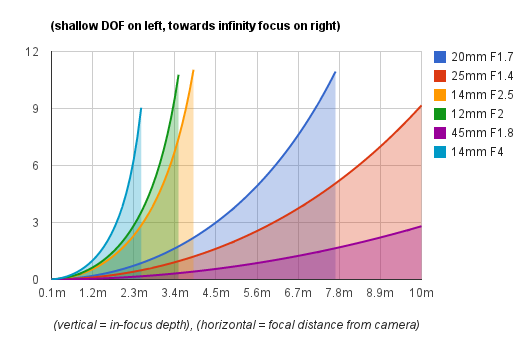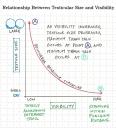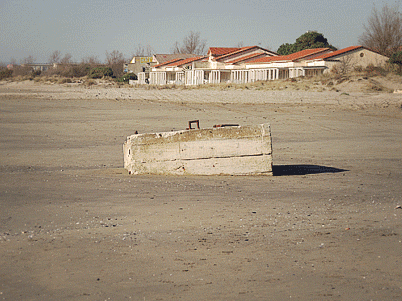
-
I just posted some research into comparing DOF for a few MFT lenses. So, I thought Id share the info so others can try out their own setups.
"I was doing some thinking about lenses and depth of field and I came up with this comparison chart for a few MFT lenses. What I really wanted to find out was, what are the limitations of shallow depth of field based on aperture, focal length, and most importantly distance from the camera. As well as how can I squeeze my lenses for as much shallow DOF as they can deliver. As I suspected the depth of field become less shallow as you move away from the camera. This is all theoretical, but I found the chart to be really interesting to compare lenses to see where the dramatic DOF fun starts and ends. Id be curious if this actually holds up in the real world."
http://www.eric-bates.com/?p=2024

-
All poppycock.
I have always carried around my Eastman hyperfocal distance chart (yellow, plastic credit-card-size) - essential when you have to shoot wild and no assistant to pull focus. All I need.
A Normal lens is an arbitrary reference point so you can talk about lenses ("give me a wide" takes on a meaning).
Amazing how - apart from comparing modern lenses - we manage to re-invent a 3,000-year-old old wheel.

-
Ok, I'll try to end this unlucky thread with some useful information :-)
@balazer, you write "Video resolutions will have greater depth of field" [than stills]. Well, that was my assumption as well, that's why I had been using a wider CoC than the 15 micron one normally recommended for stills on the GH2. But this morning I finally found the time to shoot some tests to determine the CoC I had to use for 1080 video shot with my GH2 and to my extreme surprise I found out that the suggested value for stills, that is 15 microns, still holds for video (my tests were not extremely accurate as my Leica Disto is out of the country with a friend, so it might be 14.5 or 15.5 micron, but that's more than enough precision for me). Now, I don't know about 720 or about other cameras, and I'm still surprised by the result, but I guess I'll have to dial back my DoF calculator to 15 micron.
-
@alcomposer lol. Actually, now that you have mentioned the nazis, I have to confess that it was the mustached guy himself that once visited me in a dream and explained to me that all this "normal lens" and "z axis distortion" talk was part of a Zionist conspiracy. ;)
-
OK, I got it. You work hard to proof this "law" :-)
-
Ok... Maybe just the Nazi thing:
http://en.wikipedia.org/wiki/Godwin's_law
If anything the below chart sums up 'trash talk flame war' cause.

 chart.jpg600 x 664 - 270K
chart.jpg600 x 664 - 270K -
isn't there the rule that given enough time 'every' thread on any forum will eventually turn into either a Flame war and/or an argument based on Nazi's?
Nope.
-
@VK isn't there the rule that given enough time 'every' thread on any forum will eventually turn into either a Flame war and/or an argument based on Nazi's?
I even think there is a term for this phenomenon.
-
Discussions abot DOF and sensor crops (and FOV) are equivalent of Mac vs PC thing :-) Flame.
-
In case anyone is interested, I posted this over at dpreview.com as well.
http://forums.dpreview.com/forums/readflat.asp?forum=1041&thread=42027675&page=1
They have taken this idea, much farther than I could have imagined. Its a great discussion on a whole slew of perspectives relating to DOF.
Thanks again everyone for your comments!!
-
@stonebat My apologies if you took my rant as a personal attack. It wasn't meant to be. In all seriousness, I've been a victim of that myth for years before finding out what was all about. And no, x and y axis distortion are all another matter, but seriously, I don't want to convince anyone, hopefully Anton Wilson will. I was just trying to be of help by pointing people to a very interesting read.
Peace.
-
There's a zillion examples of all lenses at all apertures in stills and videos online. Throw the theory out the window and just browse for the "look" you want. My Vivitar 58 and Russian 58mm have a totally different look, different bokeh, different edges, different shadow detail, contrast, color and so on. The difference is startling, and click the aperture ring one stop and yet another "look" as the iris changes shape. Move the cam forwards and back so the FOV is the same as another lens, and yet again, a different look for the same FOV. Plug the cam into a big, flat screen TV and start playing around with the lenses. Learn the look, pick the lens, adjust the settings. If shallow DOF is what you want, don't get the 14mm :)
-
The fact that a lens can distort along the z axis is only a myth. A myth that is part of the complex mythology surrounding the purported existence of "normal" lenses. A long time ago, the concept of a "normal lens" made sense in certain contexts, but not anymore. That concept, before becoming obsolete, was regrettably transformed into a myth, and myths unfortunately never die.
Anyone interested in knowing more about the misconceptions surrounding the existence of a normal lens can start by giving a look at Anton Wilson's excellent Cinema Workshop (from page 99 to 102):
Hope this helps.
-
I'd use 75mm 1.8 instead of 20mm 1.7 if I want a long shot with very blurred background in a city street. The longer focal length, the larger circle of confusion, the shallower DOF.
"Long focal length lenses, also called telephotos, have a narrower field of view than normal and wide angle lenses, and compress space along the z axis of the frame. Because of this, telephoto lenses appear to bring the background of an image closer to the foreground, flattening space; movement along the z axis is also distorted." - The Filmmaker's Eye
Here's the z axis distortion.


 HitchcockZoom_Micael_Reynaud.gif402 x 301 - 3M
HitchcockZoom_Micael_Reynaud.gif402 x 301 - 3M -
One Ring to rule the DOF, One Ring to find sensor crop factor,
One Ring to bring them all and in the flame wars bind them -
Depth of field has everything to do with resolution. The image projected by the lens is sharper for objects that are closer to the focal plane, but within the focus field, everything looks equally in-focus because the circles of confusion are smaller than the output pixels. It's only when the circles of confusion start to be bigger than the output pixels that we start to see them as circles instead of as points or pixels. Typically for depth of field calculations you use a circle of confusion diameter criterion equal to the output pixel pitch.
It's not just theoretical. It totally bears out in practice, and there's a huge difference between the resolution of the GH2's 16-megapixel stills and the 1-2 megapixel video.
Don't confuse depth of field with bokeh size. You can get bigger bokeh with larger aperture lenses and/or close objects, independent of the resolution.
-
Psyco, I think in a technical way, you do have a point in that the distances in real world where the images become blurred/in-focus may not change across different focal lengths. But, I have to agree with Stonebat. In the screen space of the final image (aka, the results), those objects have the appearance of being more blurred as they become larger in frame. I'm all for a semantic debate though:)
@DrDave, speaking of semantics, what do you mean by "the 14mm are hyperfocal"?
-
@stonebat That video does not proof oder disproof my statement.
Look at the tower in the background, it has the same amount of blur (as far as one can tell with youtube compression) it just gets bigger when the focal length increases. If you take the tower at the end of the shot and resize it to its size at the beginning, I think there would be no difference. (But the video quality is to bad to be sure.)
Howdy, Stranger!
It looks like you're new here. If you want to get involved, click one of these buttons!
Categories
- Topics List23,993
- Blog5,725
- General and News1,354
- Hacks and Patches1,153
- ↳ Top Settings33
- ↳ Beginners256
- ↳ Archives402
- ↳ Hacks News and Development56
- Cameras2,368
- ↳ Panasonic995
- ↳ Canon118
- ↳ Sony156
- ↳ Nikon96
- ↳ Pentax and Samsung70
- ↳ Olympus and Fujifilm102
- ↳ Compacts and Camcorders300
- ↳ Smartphones for video97
- ↳ Pro Video Cameras191
- ↳ BlackMagic and other raw cameras116
- Skill1,960
- ↳ Business and distribution66
- ↳ Preparation, scripts and legal38
- ↳ Art149
- ↳ Import, Convert, Exporting291
- ↳ Editors191
- ↳ Effects and stunts115
- ↳ Color grading197
- ↳ Sound and Music280
- ↳ Lighting96
- ↳ Software and storage tips266
- Gear5,420
- ↳ Filters, Adapters, Matte boxes344
- ↳ Lenses1,582
- ↳ Follow focus and gears93
- ↳ Sound499
- ↳ Lighting gear314
- ↳ Camera movement230
- ↳ Gimbals and copters302
- ↳ Rigs and related stuff273
- ↳ Power solutions83
- ↳ Monitors and viewfinders340
- ↳ Tripods and fluid heads139
- ↳ Storage286
- ↳ Computers and studio gear560
- ↳ VR and 3D248
- Showcase1,859
- Marketplace2,834
- Offtopic1,320











